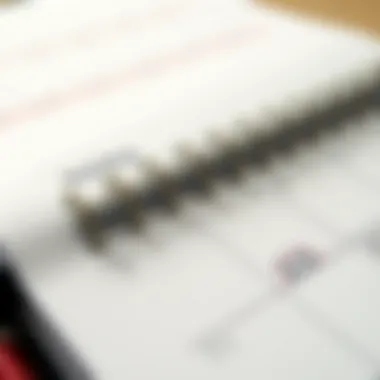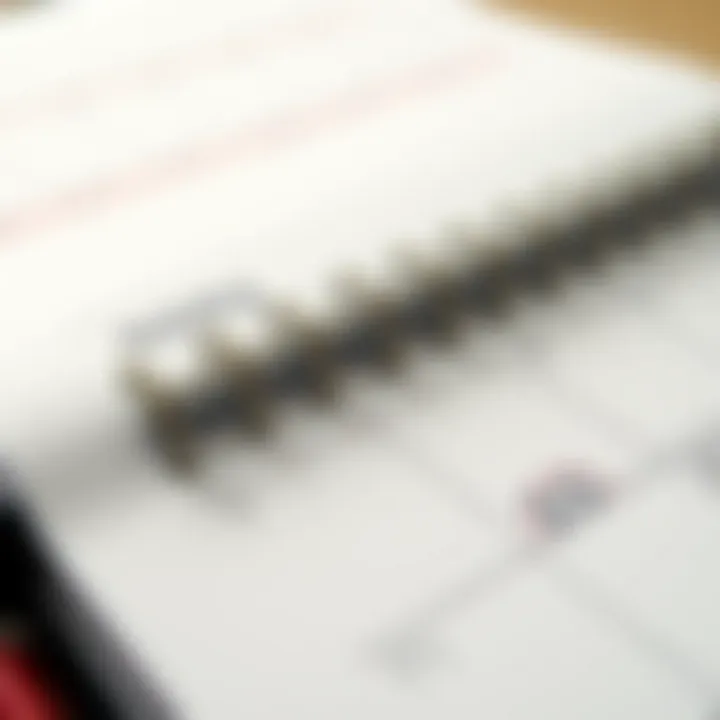Maximizing Productivity with Magnetic Week Planners


Intro
As the world spins faster, many find themselves caught in the whirlwind of schedules and commitments. The magnetic week planner has emerged not just as a tool for organization but also as a stylish and practical accessory to those looking to gain control of their time. With rapidly shifting demands in personal and professional realms, these planners offer an innovative solution that goes beyond mere design.
Why Magnetic?
Magnetic week planners are gaining traction for a variety of compelling reasons. For starters, the simplicity of using magnets allows for easy repositioning. Unlike traditional planners that might be bound in books, magnetic planners can be moved seamlessly on any metallic surface. This feature delivers flexibility to adapt to changing schedules, making it a vital tool for modern-day multitaskers.
Furthermore, the visual aspect cannot be overlooked. Data shows that visual planners often enhance retention and understanding of tasks at hand, channeling the old adage “out of sight, out of mind” into a productive light. Displaying your week prominently on a fridge or an office board allows for a constant reminder of priorities, significantly elevating time management practices.
This article aims to peel back the layers of utility offered by magnetic week planners, highlighting their influence on productivity, their unique design elements, and how they effectively integrate into diverse environments. Whether you are a busy professional trying to juggle meetings or a parent managing family activities, these planners can reshape your approach towards planning and organization.
With that in mind, let’s dive into the current fashion trends surrounding magnetic week planners.
Understanding Week Planners
Exploring the realm of week planners is vital, especially in today’s fast-paced world. Week planners not only help in keeping track of tasks but also cultivate a sense of control over one’s time. They serve as more than mere organizational tools; they’re a lifeline to balance the chaos that often surrounds our daily schedules. With the myriad of choices available, understanding the intricacies of week planners, particularly magnetic ones, allows individuals to tailor their planning experience to suit their lifestyle needs.
When diving into this subject, it becomes essential to highlight both the functionality and the emotional satisfaction that comes from seeing a week neatly organized on a single board. Magnetic week planners, in particular, have unique features that facilitate this process, allowing for dynamic task organization that caters to both spontaneous and structured individuals alike.
Defining the Concept of a Week Planner
At its core, a week planner is a visual representation of tasks and commitments arranged within a seven-day framework. The art of planning extends beyond jotting down appointments. It encompasses the effective organization of various facets of life, from personal engagements to professional responsibilities. In essence, these planners allow users to visualize their entire week at a glance, promoting beneficial habits and consistency. The beauty of the magnetic week planner lies in its ability to be customized and repositioned, lending a tactile element to planning that enhances interaction. Individuals can place tasks at eye level, making it easier to remain aligned with goals and timelines.
Historical Evolution of Planning Tools
Over time, the tools we use for planning have evolved significantly. Initially, the humble paper planner was the backbone of organization for countless individuals, embodying a straightforward approach to scheduling. The transition from paper-based systems to digital formats marked a significant turning point.
From Paper to Digital
Transforming planning from paper to digital marked a radical shift in accessibility and efficiency. Digital calendars offered the ability to sync across multiple devices and receive reminders, making it a convenient choice for on-the-go users. The key characteristic of this transition was flexibility. Users could change their schedules with mere taps instead of crossing out text or rewriting pages. One primary advantage of digital tools is connectivity – tasks can be shared easily among teams ensuring everyone stays on the same page, literally. However, some find the lack of a physical, tangible representation of their week to be limiting. The essence of interaction gets dull when everything is purely digital.
The Advent of Magnetic Options
With the development of magnetic week planners, a hybrid approach emerged. This unique style combines elements of paper planners with the dynamic adaptability of digital tools. The magnetic feature allows users to effortlessly modify their plans according to changing priorities without the need for rewriting. The appeal lies in the tactile interaction; being able to physically move tasks can provide an engaging solution to planning. This characteristic has made magnetic planners a burgeoning choice among both home and office users, as they embody a blend of functionality and customization. The inherent advantage in that ease of modification promotes continuous engagement with one’s planning process. However, they do require a dedicated space, something digital planners typically do not need.
The Appeal of Magnetic Week Planners
Magnetic week planners have rapidly gained popularity among those seeking organization and productivity in both personal and professional realms. They offer more than just a method to jot down tasks; they create an interactive experience that enhances one's engagement with their schedule. Combining aesthetic design with functional applications, these planners cater to users who value both visual appeal and practicality. Now, let's examine what makes these planners so appealing.
Unique Design Features
Sleek Aesthetic Properties
The visual allure of magnetic week planners sets them apart from their traditional paper counterparts. Their sleek and modern design can elevate any workspace or home environment. Often made with vibrant colors and smooth finishes, these planners don't just serve a purpose; they are a statement piece. The unique feature that makes these planners a popular choice is the customizable surface that allows for personal touches—think bright markers or magnetic stickers that match your vibe. This blend of aesthetics and functionality is hard to resist for anyone wanting to make their planning process more delightful.
Incorporating sleek designs not only adds to the visual atmosphere but can also motivate users to engage with it regularly. It combines beauty with utility, making the act of planning feel less like a chore and more like a creative exercise.
Functional Adaptability
The flexibility of magnetic week planners is a significant aspect of their design. They adapt easily to various needs, whether it’s weekly scheduling for family duties or tracking professional projects. Their magnetic backing allows users to reposition them with ease, ensuring they can adjust their views as tasks shift. This feature is a welcome difference compared to traditional planners where adjustments can often lead to chaos or disorganization.
Customizability is another key characteristic of functional adaptability. Users can choose from diverse layouts, ranging from minimalist grids to intricate designs tailored to individual preferences. This versatility makes them a beneficial choice for various users—be it students, parents, or professionals—offering a way to align their planner style with their personal workflows.
Material Advantages
Durability and Longevity
One of the standout traits of magnetic week planners is their durability. Unlike paper planners that may suffer wear and tear over weeks or months, magnetic planners are designed to withstand daily usage without losing their effectiveness. The robust materials used, often a combination of plastic and metal components, ensure these planners remain functional without fraying at the edges or fading over time.


This durability not only represents a financial investment but also reflects an eco-friendly choice for those concerned about sustainability. By opting for a long-lasting planner, you reduce the need to replace it frequently, thereby minimizing waste.
Ease of Cleaning and Maintenance
Keeping a planner tidy doesn't need to feel like a daunting task, especially with magnetic planners. Their surfaces are often wipeable, allowing for effortless removal of smudges or stray notes. This is especially valuable in environments that can be messy, such as homes with children or bustling offices. A quick swipe with a damp cloth can restore the planner's sleek appearance in no time.
The ease of maintenance makes these planners an attractive option, especially for those who value cleanliness and organization. It invites users to engage with the planner more freely, as they aren’t burdened by the fear of ruining a page or two. The straightforward upkeep adds another layer of charm to the practicality of magnetic week planners.
Enhancing Productivity with Magnetic Week Planners
Magnetic week planners have emerged as a game changer in the realm of productivity tools. Their unique design and functionality cater to the evolving demands of today’s fast-paced environment. A planner designed to stick to a surface opens up a world of possibilities, particularly in terms of organization, accountability, and workflow optimization. This section delves into the specifics of how magnetic week planners enhance productivity through efficient visual organization and fostering accountability and motivation.
Visual Organization of Tasks
Color-Coding Techniques
Color-coding is not just a technique; it's a strategy that distinguishes essential tasks at a glance. By assigning specific colors to various categories—like work-related tasks in blue and personal errands in green—users can quickly sort through their commitments. This visual segmentation becomes a powerful tool in maintaining clarity and order in an often chaotic schedule.
One of the standout features of color-coding is its psychological impact on the user. Bright colors can invoke attention and elicit feelings of urgency or calm, depending on the task. For instance, using red for deadlines can create an immediate sense of importance, prompting action. This method also simplifies the process of prioritizing tasks, allowing users to manage their time more efficiently.
However, it's important to not overdo it. Too many colors can confuse rather than clarify. Finding a balance ensures that the system remains a tool for enhancement rather than a hurdle.
Spatial Arrangement Methods
Spatial arrangement refers to the thoughtful positioning of tasks within the planner, making the best use of space available. This method allows individuals to adapt their workflows dynamically. For example, placing high-priority tasks at the top or central part of the planner ensures they capture attention first.
What makes spatial arrangement effective is its ability to create a physical representation of one's workload. Outside observers can also grasp the user's priorities by just glancing at the planner's layout. This feature is tremendously beneficial in collaborative environments where transparency can lead to better team dynamics and cooperation.
Nonetheless, spatial arrangement requires discipline and constant tweaks as priorities shift. It's not a set-it-and-forget-it approach. A planner may need to be regularly updated to reflect the current state of tasks accurately.
Increased Accountability and Motivation
The Role of Visibility
Visibility is a powerful factor when it comes to enhancing productivity. The sheer presence of a magnetic planner in one's workspace serves as a constant reminder of what needs to get done. This consistent sight helps keep tasks top-of-mind and minimizes the chance of procrastination. When goals are out of sight, they can easily fall to the wayside.
Interestingly, making tasks visible also introduces peer accountability. In a shared office setting, for example, colleagues can see what others are working on, fostering a sense of collective responsibility. This dynamic can spark conversations around goals and progress, further motivating individuals to stay on track.
However, visibility can sometimes lead to pressure. If someone feels overwhelmed by the tasks they see, the planner might cause stress instead of relief. Hence, balance is key to maintaining a positive effect on the user’s motivation.
Goal Setting and Tracking
Setting clear and attainable goals within a magnetic week planner creates a framework for success. By mapping out both short-term and long-term objectives, users can track their progress visually. This not only aids in maintaining focus but also instills a sense of accomplishment when tasks are checked off the list.
The unique feature here lies in the ability to revisit and reflect upon goals consistently. Many planners come with a space for reflections or notes that can help assess what worked and what didn’t. This iterative approach to goal setting allows individuals to refine their strategies continually.
Nonetheless, setting too many grand goals can dilute focus and lead to frustration. It's vital to target a manageable number of objectives each week to prevent overwhelm and to enhance the overall effectiveness of the magnetic week planner.
Customization and Personalization Options
Customization in magnetic week planners isn’t just a trend; it’s a reflection of individual needs and styles. This section delves into how these planners can be tailored to fit both personal tastes and functional requirements. By considering unique themes, layouts, personal touches, and tech integrations, users can transform their week planner into a powerful organizational tool, making planning intuitive and enjoyable.
Bespoke Design Inspirations
Choosing Themes and Layouts
Selecting the right theme and layout for your magnetic week planner can significantly enhance your planning experience. Each theme can convey a different vibe—whether it’s a minimalist monochrome design or a vibrant botanical print, the visual appeal can set the tone for your planning sessions. A key characteristic here is that themes cater to various preferences; some folks prefer calming neutrals while others thrive on bright colors.
The advantage of this customizable aspect lies in personal expression, allowing users to align their planner with their lifestyle. A well-chosen layout not only adds to the aesthetic but also boosts functionality. For example, a layout with clearly defined sections for work, family, and personal projects can provide clarity at a glance. However, it’s essential to pick a layout that won’t overwhelm; too much complexity can lead to confusion rather than organization.


Adding Personal Touches
Every individual has unique tastes, and adding personal touches to a week planner provides a sense of ownership. Incorporating favorite quotes or images can inspire motivation throughout the week. A key characteristic of this personalization is the emotional connection it builds, making the planner more than just a tool—it becomes a cherished aspect of daily life.
Moreover, adding personal elements can reflect one’s journey and growth. Users may include milestone markers or memories—pictures from a family trip or motivational stickers. However, there's a balancing act; too many personal elements can detract from the planner’s primary function if it becomes cluttered. It’s crucial to create a tasteful blend that enhances the planner’s utility without compromising its organization.
Integrating Technology
Smart Features and Connectivity
Integrating smart features into magnetic week planners is a leap toward modern convenience. This allows planners to connect with various devices and apps, resulting in a seamless planning experience. A standout feature here is the ability to synchronize tasks and deadlines across different platforms. For instance, connecting your planner to a digital calendar can help eliminate the risk of double-booking or missing appointments.
The benefits of connectivity are significant, primarily in terms of real-time updates and reminders. This integration encourages users to adopt a forward-thinking approach to managing their schedules. However, without proper management, the influx of notifications can become overwhelming or distracting, which can counteract the planner's intention.
Applications and Companion Tools
Companion applications for magnetic week planners enrich the planning experience, providing useful functionalities that complement the physical planner. These applications can include features like automated reminders or collaborative planning tools that allow multiple users to adapt and evolve their schedules together.
One effective aspect of these tools is their adaptability—users can choose from various applications based on their specific needs, be it for personal, family, or work-related planning. This flexibility is a significant advantage for those who juggle diverse responsibilities. On the downside, navigating multiple applications may require a learning curve for some individuals, and not everyone may feel comfortable relying heavily on technology for their scheduling needs.
Magnetic Week Planners in Different Environments
Magnetic week planners serve as versatile tools that extend their utility across various settings, enhancing organization and productivity. Understanding their application in different environments is crucial as it emphasizes the adaptability of these planners. Whether it’s managing family schedules at home or coordinating tasks in an office, magnetic planners offer visual and tactile advantages that can suit a plethora of needs.
Home Use
Family Scheduling
Family scheduling is often a juggling act. Households with busy members—including parents, children, and even pets—can benefit immensely from a magnetic week planner. The key characteristic of family scheduling lies in its ability to provide a comprehensive view of everyone’s commitments in one glance. This is especially ideal for avoiding conflicts and ensuring smooth operations.
One unique aspect of these planners is that they can be placed on a fridge or any metallic surface, allowing them to become a focal point in family communication. Using colorful magnets or markers helps to differentiate tasks by family member or urgency levels. The advantages of this method include not just clear visibility but also engagement from all family members. It encourages children to see their own responsibilities and aids in teaching them planning skills from a young age.
"Keeping everyone in the loop is half the battle won when managing a household, and a magnetic planner does that well."
Meal Planning
Meal planning, much like family scheduling, plays a vital role in maintaining an organized home. Incorporating a magnetic week planner for meal planning greets every family member with a clear agenda of the week’s meals. This key characteristic turns dinner-time chaos into a structured process, making grocery shopping more efficient and minimizing food waste.
What makes meal planning with magnetic planners unique is their adaptability to rapid changes, like a last-minute schedule shift. The ease with which one can erase and rewrite tasks allows for flexibility. However, while the visual organization is beneficial, there may be a learning curve in maintaining consistent updates, especially in households with varying schedules.
Office Settings
Team Collaboration
In a corporate environment, fostering team collaboration can be challenging with everyone glued to their screens. Magnetic week planners facilitate this by acting as a central point of communication for the team. Their presence in common areas can spur conversations about project statuses and upcoming deadlines. The hallmark of effective team collaboration is clarity, and these planners provide that in spades.
One notable feature of magnetic planners is that they can be updated dynamically. Team members can add sticky notes or magnets to prioritize tasks or flag who is responsible for each item. This interactivity not only keeps everyone aligned but also encourages accountability. The downside might be that, when overused, these planners can become cluttered, potentially leading to confusion instead of clarity.
Project Management
Project management often necessitates a structured approach to lead teams toward common goals. When used in this context, magnetic week planners transform from simple to-do lists to sophisticated project trackers. They provide a visual representation of timelines and milestones, thereby aiding in strategic planning.
The critical characteristic of project management through planners is the ability to group and visualize tasks according to phases of the project lifecycle. For instance, using different colored magnets for various project stages—like research, development, and review—can holistically map out progress over time. This method promotes not just individual responsibility but team dynamics as well. However, akin to team collaboration, if these planners are not regularly maintained, they can lose effectiveness, making it essential for team members to commit to their updates.
In summary, magnetic week planners shine in various contexts—be it at home or in office settings—by offering adaptability, visibility, and organization. They’re not just tools but allies in navigating the complex web of daily tasks and commitments.
The Impact of Magnetic Week Planners on Time Management
Managing time effectively is a cornerstone of productivity, yet it remains a challenge for many. Magnetic week planners serve as a bridge between chaotic schedules and organized living. They stand out as a practical tool that allows for visible tracking of ongoing tasks that dividends can be reaped from both personal and professional lives. These planners help users grasp their schedules, laying the groundwork for establishing priorities as well as coping with deadlines.


Establishing Priorities
Daily vs. Weekly Planning
One of the first steps in effective time management is deciding between daily and weekly planning. Daily planning involves breaking down your day into specific tasks and hours, while weekly planning provides a broader view, allowing you to map out the week’s agenda in one glance. This holistic approach can provide clarity, which serves as a foundation for effective prioritization.
Daily planning excels in the realm of immediate, detailed scheduling but may sometimes lead to underestimating time required for larger tasks. On the other hand, weekly planning offers an expansive horizon, letting you effectively stretch ambitions across multiple days.
The unique feature of weekly planning is how it presents a bird’s-eye view of the tasks that need to be accomplished. This bird's-eye view can help in understanding how much time needs to be allotted to various activities, reducing the risk of overwhelm that comes with day-by-day minutiae.
Strategic Task Allocation
Once priorities are defined, the next step is to allocate tasks strategically across the available time. This isn't just about checking off boxes, but rather about syncing tasks with a person’s natural productivity cycles. For instance, some individuals perform better in the morning, so they may assign more significant tasks when their energy is higher.
Strategic task allocation helps wear the many hats we juggle in our lives—from professional obligations to personal engagements. This nuanced approach involves evaluating which tasks can share the same time slot or deciding how to adjust schedules according to deadlines and work load. Thus, successful allocation can lead to an overall smoother experience and diminishes feelings of being overwhelmed by responsibilities.
In crafting availability on a week planner, individuals can more comfortably manage tasks without feeling the urgency typical in daily to-do lists.
Coping with Deadlines
Visualizing Time Constraints
One prominent aspect underpinning effective time management is the capacity to visualize deadlines. Magnetic week planners are particularly potent in this area, as they allow deadlines to be displayed visibly where one can’t miss them. With deadlines clearly marked, individuals are less likely to fall into the trap of procrastination. You can see at a glance how much time is left to complete essential tasks.
This visual element of planning makes it easier to identify any congestion in the schedule and to reallocate tasks accordingly, allowing for improvements.
Managing Workload Balance
Balancing a workload can feel like walking a tightrope, but it’s essential for maintaining both mental health and productivity. Magnetic week planners come into play here by helping individuals assess how tasks are distributed over the week. One can see where potential conflicts or overlaps might arise. The visual nature of these planners allows users to make adjustments in real-time, ensuring there’s ample space to breathe between projects.
Through the use of magnetic planners, you can tag light days and heavier workloads, which can guide adjustments in scheduling. Moreover, effective workload management leads to a reduction in stress, making multitasking feel more manageable.
"The secret of your future is hidden in your daily routine." - Mike Murdock
In summary, the impact of magnetic week planners on time management is undeniably profound, allowing individuals to establish priorities, cope with deadlines, and manage workload effectively. By incorporating these strategies into everyday life, achieving a balanced and organized schedule becomes not just a possibility but a readily attainable reality.
Concluding Thoughts on Magnetic Week Planners
As we wrap up our exploration of magnetic week planners, it's essential to consider the significant role they play in today's fast-paced world. These planners are more than mere organizational tools; they represent a bridge between chaos and control. For individuals trying to manage personal and professional demands, the use of magnetic week planners can truly transform how time is perceived and utilized.
Summarizing Key Benefits
To distill the key advantages of magnetic week planners, consider the following points:
- Visual Clarity: With their magnetic nature, these planners can transform any bland wall into a vibrant focal point of functionality. They allow tasks to be rearranged easily, offering flexibility at a moment’s notice.
- Enhanced Productivity: By providing an overarching view of weekly tasks, individuals can prioritize effectively. This leads to not just planning but actual doing, as it's easy to see the tasks at hand and allocate time accordingly.
- Customizable Experience: Beyond the basic functionality, the personalization options allow for creative themes or styles that resonate with an individual's taste. This makes planning an engaging activity rather than a mundane chore.
- Coordination among Teams: In office settings, the visibility of tasks on a magnetic planner fosters collaboration. Everyone can see the scope of work, making it easier to delegate.
Through these aspects, magnetic week planners help streamline processes, reduce stress, and enhance overall productivity.
Future Trends and Innovations
Looking ahead, there are some promising trends and innovations that are shaping the future of magnetic week planners. These developments not only enhance their functionality but also their relevance in everyday life.
Sustainability in Materials
As environmental awareness grows, the demand for sustainable materials becomes more evident. Magnetic week planners are increasingly utilizing eco-friendly materials, minimizing their carbon footprint. Materials like recycled plastics or biodegradable components are being integrated, which aligns with global movements toward sustainability.
- Key Characteristics: These materials are often durable yet less harmful to the environment, making them a responsible choice. Sustainability is not just a trend; it's becoming a necessity, resonating with consumers who value ethical production.
- Unique Feature: Innovations in this space often include the use of non-toxic inks or customizable layouts printed on eco-smart surfaces. This aspect of sustainability elevates the appeal for fashion enthusiasts looking for products that align with their values.
Potential Technology Advancements
In terms of technological advances, the intersection of smart technology and magnetic planners offers fascinating possibilities. Integration with smartphones or smart home devices could transform how users interact with their planners.
- Key Characteristic: Advancements in connectivity mean that tasks on physical planners can sync with digital calendars, ensuring the user never misses a deadline. This blended approach caters to a tech-savvy audience keen on finding streamlined solutions.
- Unique Feature: Imagine a future where your magnetic planner could voice reminders or adjust your tasks in real-time based on your changing schedule. Such innovations would not only cater to the busy professional but also network with other smart devices to enhance the overall organizational experience.
In summary, magnetic week planners are entering a transformative phase, fueled by sustainability and smart tech. The progression in materials and technology should excite those of us keen on efficiency, organization, and overall lifestyle enhancement. Keeping abreast of these trends ensures that we not only remain relevant in our time management practices but also optimistic about the future.







